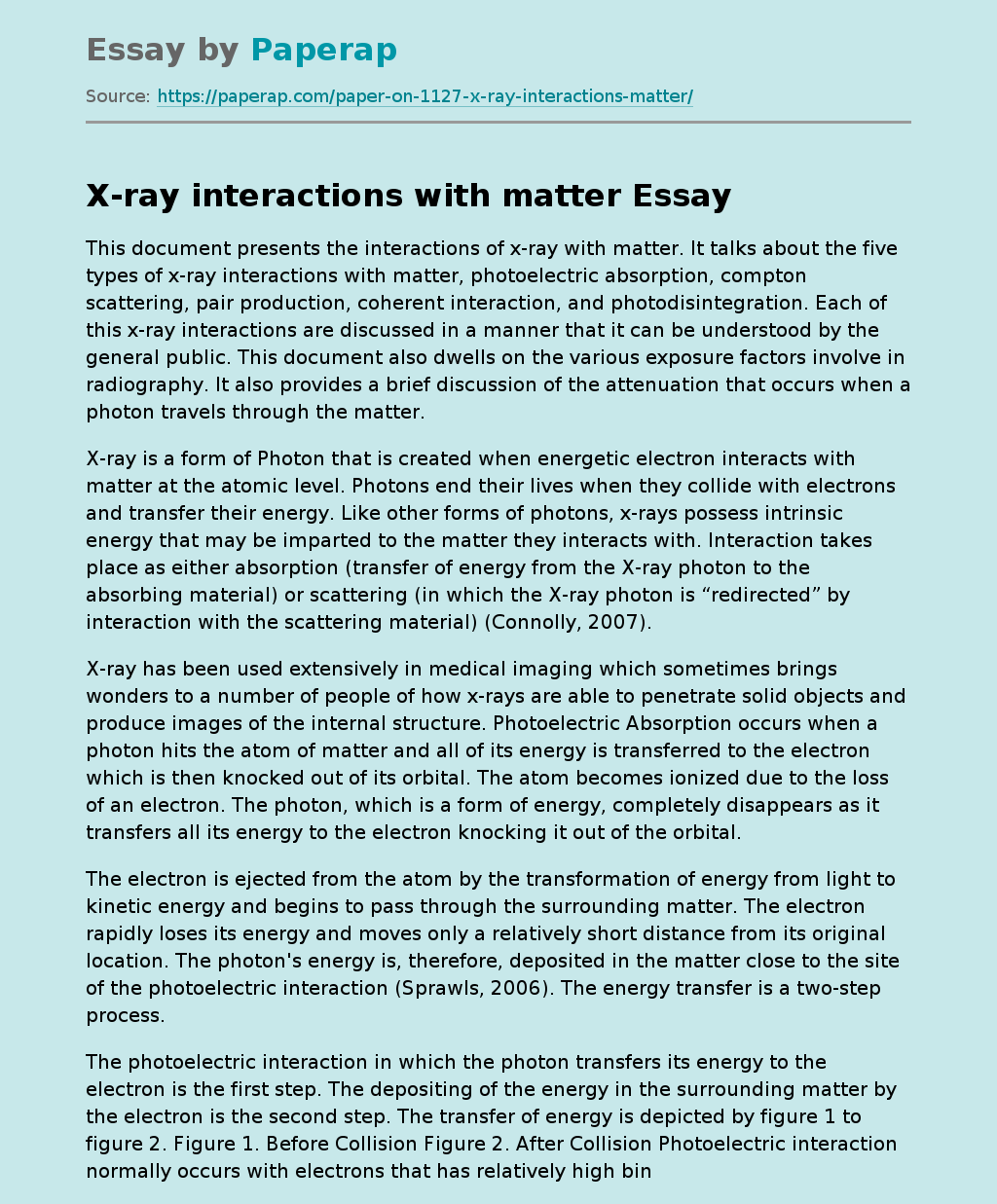X-Ray Interactions With Matter
The following sample essay on X-ray interactions with matter This document presents the interactions of x-ray with matter. It talks about the five types of x-ray interactions with matter, photoelectric absorption, compton scattering, pair production, coherent interaction, and photodisintegration. Each of this x-ray interactions are discussed in a manner that it can be understood by the general public. This document also dwells on the various exposure factors involve in radiography. It also provides a brief discussion of the attenuation that occurs when a photon travels through the matter.
X-ray is a form of Photon that is created when energetic electron interacts with matter at the atomic level. Photons end their lives when they collide with electrons and transfer their energy. Like other forms of photons, x-rays possess intrinsic energy that may be imparted to the matter they interacts with. Interaction takes place as either absorption (transfer of energy from the X-ray photon to the absorbing material) or scattering (in which the X-ray photon is “redirected” by interaction with the scattering material) (Connolly, 2007).
X-ray has been used extensively in medical imaging which sometimes brings wonders to a number of people of how x-rays are able to penetrate solid objects and produce images of the internal structure. Photoelectric Absorption occurs when a photon hits the atom of matter and all of its energy is transferred to the electron which is then knocked out of its orbital. The atom becomes ionized due to the loss of an electron. The photon, which is a form of energy, completely disappears as it transfers all its energy to the electron knocking it out of the orbital.
The electron is ejected from the atom by the transformation of energy from light to kinetic energy and begins to pass through the surrounding matter. The electron rapidly loses its energy and moves only a relatively short distance from its original location. The photon’s energy is, therefore, deposited in the matter close to the site of the photoelectric interaction (Sprawls, 2006). The energy transfer is a two-step process.
The photoelectric interaction in which the photon transfers its energy to the electron is the first step. The depositing of the energy in the surrounding matter by the electron is the second step. The transfer of energy is depicted by figure 1 to figure 2. Figure 1. Before Collision Figure 2. After Collision Photoelectric interaction normally occurs with electrons that has relatively high binding energy. It is most probable when the electron binding energy is only slightly less than the energy of the photon.
If the binding energy of the electron is greater than the photon then photoelectric interaction cannot occur. This is because the interaction can only occur if the photon has sufficient energy to knock and overcome the binding energy, thus removing the electron from the atom. Compton Effect Compton effect occurs when a photon hits the atom of matter and only a portion of its energy is transferred to the electron. The photon still leaves the vicinity of the interaction in a direction different from the original path of the photon.
This is illustrated in figure 3. The atom also becomes ionized due to the loss of an electron. The Relativistic energy and momentum are conserved in this process1 and the scattered x-ray photon has less energy and therefore greater wavelength than the incident photon (Connolly, 2007). The photon that leaves the vicinity of the interaction may interact further with the nearby atoms until it looses all its energy or escapes the matter and goes outside.
X-Ray Interactions With Matter. (2017, May 22). Retrieved from https://paperap.com/paper-on-1127-x-ray-interactions-matter/

